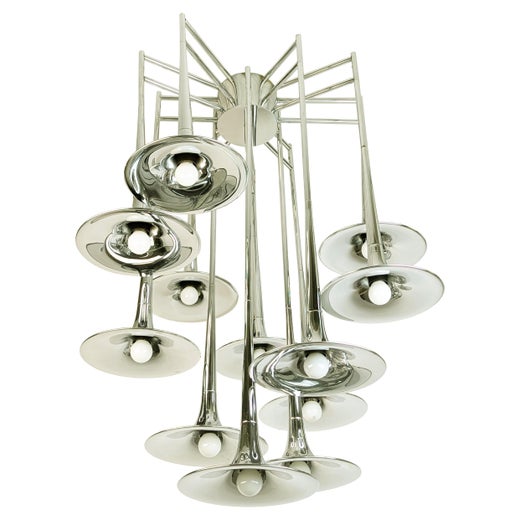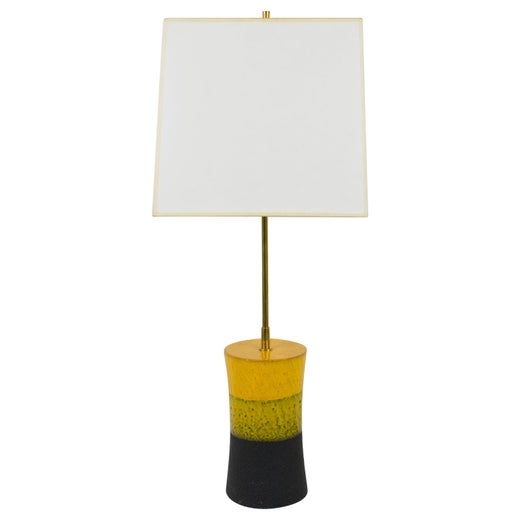Pair of Travertine Lamps by Reggiani for Raymor
About the Item
- Creator:
- Dimensions:Height: 19.75 in (50.17 cm)Width: 4.75 in (12.07 cm)Depth: 4.75 in (12.07 cm)
- Sold As:Set of 2
- Style:Mid-Century Modern (Of the Period)
- Materials and Techniques:
- Place of Origin:
- Period:
- Date of Manufacture:1970s
- Condition:Rewired. Wear consistent with age and use.
- Seller Location:West Palm Beach, FL
- Reference Number:1stDibs: LU928323672402
Reggiani
Founded in Italy in 1957 by Goffredo Reggiani, whose family still runs it, Reggiani Illuminazione today is an international company recognized as one of the world’s foremost producers of LED fixtures. Along with Venini and Kartell, the firm was part of the Italian design renaissance that took place in the middle of the last century, introducing exuberant new forms and colors for modern interiors. While Kartell and Venini specialized in plastic and glass, respectively, Reggiani has always focused on lighting, pioneering innovative technologies for every type of illumination, from wall sconces to track lights.
Reggiani rose to prominence in the 1960s with its introduction of sleek, sophisticated lighting fixtures made from wood, glass, and metal. This pair of sconces with frosted glass shades is typical of the firm’s early offerings, combining the warmth of teak — very popular at the time, thanks to the success of Danish modern furniture and accessories — with a futuristic silhouette free of embellishment. Throughout the 1960s and ‘70s, Reggiani’s chandeliers and pendant lights grew increasingly adventurous in design. Its Space Age line, featuring vivid hues and bold geometric forms, such as the cluster of spheres in this Sputnik chandelier, reflect the contemporary fascination with the space race, which influenced the design, popular culture and even fashion of the era. Inthe late 1970s, Reggiani began using acrylics in pieces like this bright orange table lamp.
Starting in the 1970s, the firm introduced the first low-voltage line of halogen lamps in Europe and, in the 1980s, debuted the Downspot. The first fully adjustable recessed electric lighting fixture, the Downspot became a popular design for track lighting, enabling architects and designers to customize illumination as never before. Today, Reggiani is at the forefront of LED lighting. In 2009, it launched the LED Luce system, which is now used in a variety of public spaces, including libraries, museums and showrooms. The firm’s Ambar fixtures were chosen for Rogers Stirk Harbour + Partners’s installation at the 15th International Architecture Exhibition of the Venice Biennale.
Raymor
Few had their finger on the pulse of American furniture like importer and distributor Raymor. Founder Irving Richards first had his eyes opened to the world of furniture while attending the 1928 Salon d’Automne art and design fair in Paris. He joined Lightolier two years later and developed its business relationships, including with designer Russel Wright.
Wright and Richards met in 1935 and Russel Wright, Inc. was formed in 1936. Its American Modern ceramic tableware, produced under the name Wright Accessories in 1938, was a notably lucrative collaboration. Following the early success of American Modern, Richards obtained the majority share of Wright Accessories and changed its name to Raymor Mfg Division Inc. in 1941.
By 1952, the exclusivity over American Modern had ended (the line was initially produced by Wright Associates and later manufactured by Steubenville for two decades). To keep up with American markets, Raymor worked with prominent designers such as George Nelson, Arthur Umanoff, Ray and Charles Eames, and Hans J. Wegner.
The company’s imports expanded to Denmark, which contributed to the rise of Scandinavian modern designs in the American market. Throughout the 1950s, Richards established relationships with factories in Scandinavia, Italy and Germany, as well as with the influential tastemaker and importer Charles Stendig.
The furniture company Simmons bought Raymor in 1963 and changed its name to Raymor Richards, Morgenthau Inc. in 1969. During that time, Raymor’s Omnibus range of Scandinavian-style wall units became widely popular, along with Italian glass and pottery like Bitossi ceramics designed by Aldo Londi and Bagni ceramics by Alvino Bagni.
Shifting styles coupled with rising competition, and the departure of Richards from the company, ended Raymor. By the late 1970s, Raymor faced a wave of international factories able to produce similar products of lesser quality for a lower cost. Buyers were eager to frequently change their interior styles, limiting the need for high-end, durable furniture, which Raymor had been importing.
On 1stDibs, find a collection of vintage Raymor ceramics, lamps, decorative objects and more.
You May Also Like
Vintage 1970s Table Lamps
Travertine, Brass, Chrome
Mid-20th Century Italian Mid-Century Modern Table Lamps
Travertine
Vintage 1970s Italian Mid-Century Modern Table Lamps
Chrome
Vintage 1950s Italian Mid-Century Modern Table Lamps
Brass
Vintage 1940s American Mid-Century Modern Table Lamps
Aluminum
Vintage 1960s Italian Modern Table Lamps
Travertine, Brass, Stainless Steel
Mid-20th Century Italian Mid-Century Modern Table Lamps
Ceramic
Vintage 1970s Italian Space Age Table Lamps
Metal
Vintage 1960s Italian Mid-Century Modern Table Lamps
Chrome
Vintage 1960s Italian Mid-Century Modern Table Lamps
Metal

